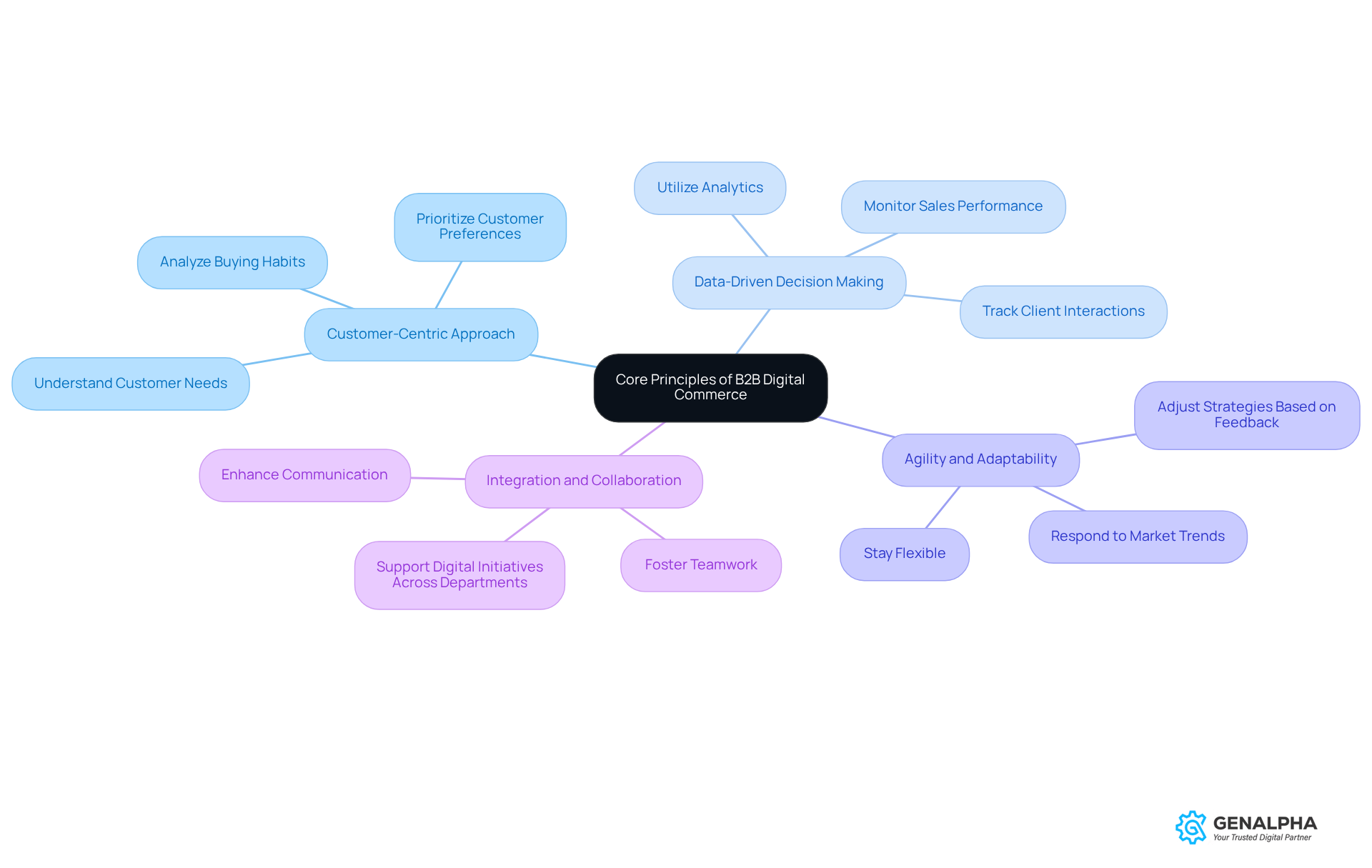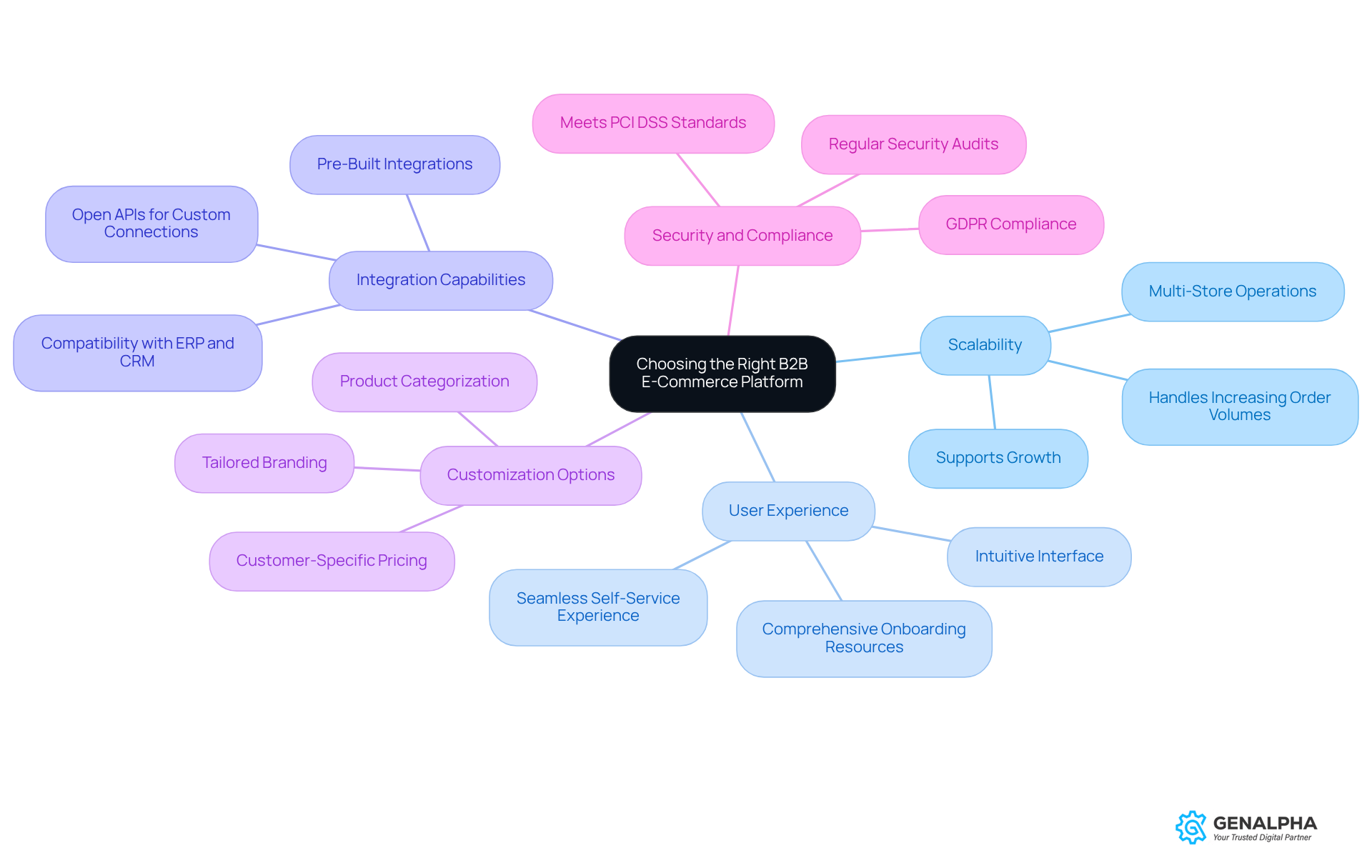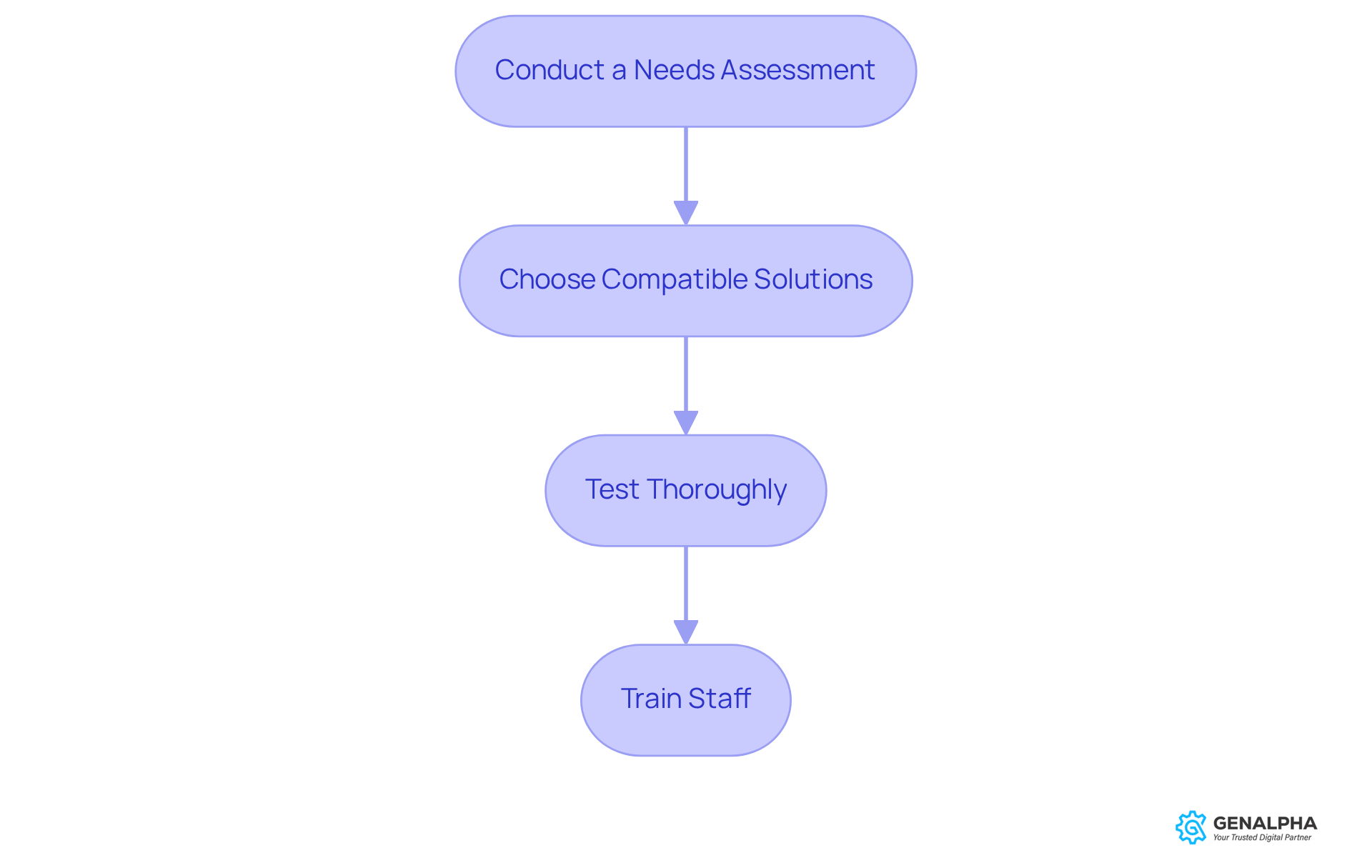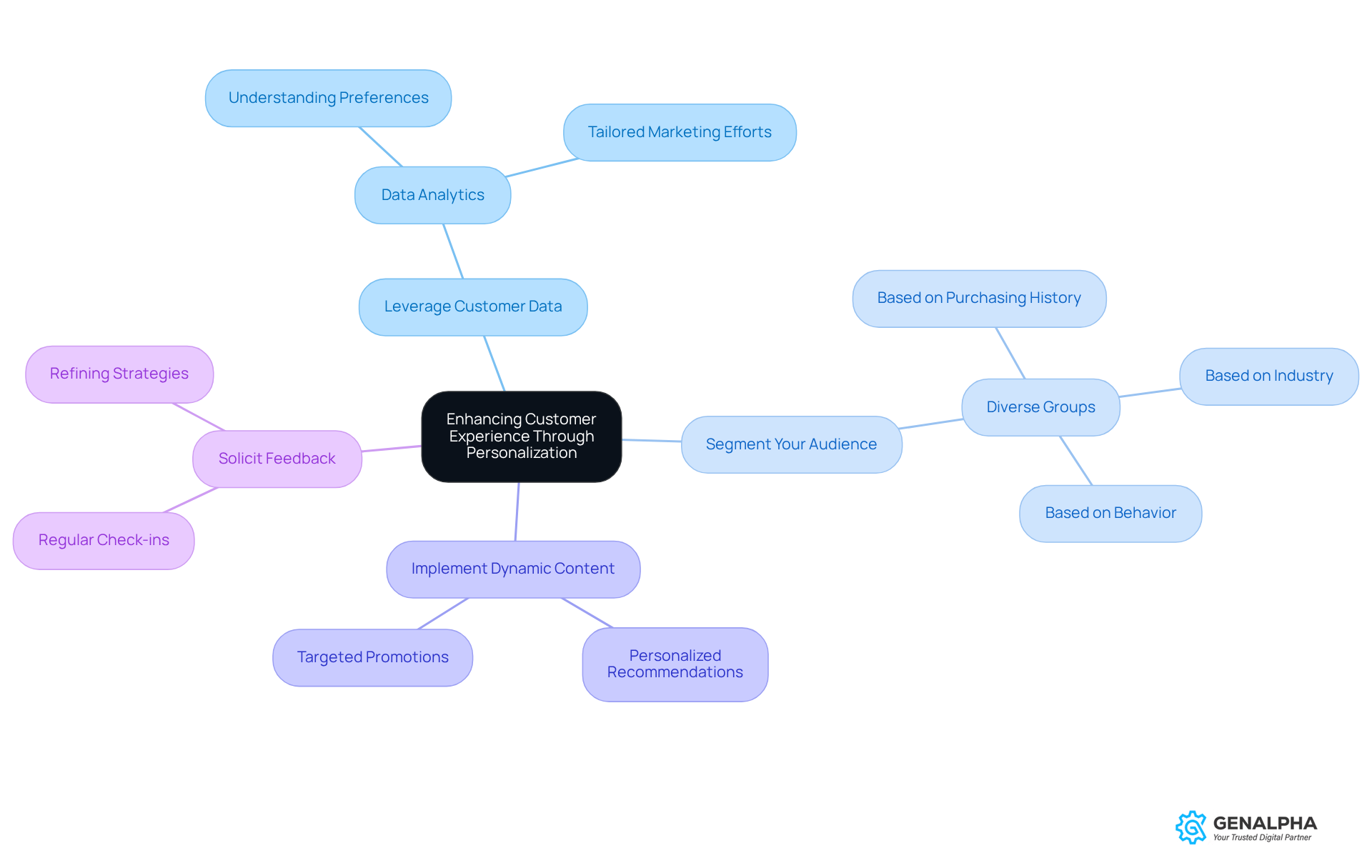Overview
Let’s talk about how manufacturers can really shine in the world of B2B digital commerce. Have you ever wondered what it takes to succeed in this fast-paced environment? Well, there are four key practices that can make a huge difference:
- A customer-centric approach
- Data-driven decision-making
- Agility
- Seamless integration with existing systems
These aren’t just buzzwords; they’re backed by solid evidence. For example, companies that focus on their customers often see improved experiences and, guess what? Increased sales! It’s clear that adopting these practices can create a strong framework for manufacturers looking to thrive in the digital marketplace.
So, why not take a closer look at these strategies? By putting customers first, making decisions based on data, staying agile, and integrating smoothly with what you already have, you can set your business up for success. What do you think? Are you ready to embrace these practices and see the benefits for yourself?
Introduction
In the fast-paced world of B2B digital commerce, manufacturers are at a crossroads filled with both exciting opportunities and tough challenges. Have you ever wondered how to craft a digital strategy that really resonates? It’s not just about keeping up with market trends; it’s about putting customer needs front and center and making decisions based on solid data.
As competition heats up, the big question is: how can manufacturers navigate the tricky waters of digital commerce to boost customer experience and drive growth? This article dives into some best practices that can truly transform your B2B digital strategies. Let’s ensure you not only keep pace but thrive in this ever-changing landscape!
Establish Core Principles of B2B Digital Commerce
To really thrive in digital commerce B2B, manufacturers need to kick things off by laying down some core principles that truly reflect their business values and what their clients expect. So, what should these principles look like?
- Customer-Centric Approach: First and foremost, it’s all about the customers! Make their needs and preferences the top priority in every part of your digital strategy. This means getting to know their buying habits and the challenges they face.
- Data-Driven Decision Making: Next up, let’s talk about the power of analytics. Use data to shape your strategies and track your success. Keep an eye on how clients interact with your brand and how sales are performing, so you can keep improving your approach.
- Agility and Adaptability: The digital landscape is always changing, right? That’s why it’s crucial for companies to stay flexible and ready to tweak their strategies based on market trends and feedback from consumers.
- Integration and Collaboration: Finally, let’s not forget about teamwork! Foster a culture where all departments work together to support digital initiatives, from sales to customer service.
By setting these core principles in place, organizations can build a solid framework that effectively guides their digital commerce B2B efforts. So, are you ready to take your B2B digital strategy to the next level?

Choose the Right B2B E-Commerce Platform
Choosing the right platform for digital commerce B2B can feel like a daunting task, right? But don’t worry, we’re here to break it down into some key factors that really matter:
-
Scalability: You want a platform that can grow alongside your business. Think about it—can it handle more products and customers without slowing down? A scalable solution is essential for long-term success, especially since the digital commerce B2B market is expected to hit a whopping $25.65 trillion by 2028.
-
User Experience: Imagine navigating a clunky system—frustrating, isn’t it? The platform should offer an intuitive interface for both buyers and sellers, making transactions a breeze. A smooth user experience can really boost sales in digital commerce B2B, especially as B2B buyers increasingly crave a seamless, self-service experience.
-
Integration Capabilities: Look for platforms that play nice with your existing systems, like ERP and CRM. This ensures your data stays consistent and your operations run smoothly. As Robin Strathdee puts it, "Without smooth integrations, your enterprise could encounter inefficiencies that hinder operations and annoy clients." And who wants that? Successful integration can lead to happier customers and better performance in digital commerce B2B.
-
Customization Options: Every business is unique, so you’ll want a system that can be tailored to your specific needs. This includes branding, product categorization, and customer-specific pricing. These features can really enhance the purchasing experience for your clients in digital commerce B2B.
-
Security and Compliance: Let’s face it—digital commerce B2B transactions involve sensitive information. It’s crucial to ensure your platform meets industry standards like PCI DSS for secure payments and GDPR for data privacy. Security isn’t just a nice-to-have; it’s essential for building trust.
Now, here’s something to think about: a leading equipment manufacturer recently adopted a new e-commerce system that boasted extensive customization and integration capabilities. The result? A remarkable 30% increase in online sales in just the first year! This really highlights the tangible benefits of choosing the right system.
So, what do you think? Are you ready to dive into the world of B2B e-commerce platforms?

Integrate with Existing ERP Systems
Integrating your e-commerce platform with existing ERP systems can really boost your operational efficiency. So, how do you make this happen? Here are some friendly tips to get you started:
- Conduct a Needs Assessment: First things first, figure out what data and processes you need to integrate. Think about inventory levels, order processing, and customer data. What’s essential for your business?
- Choose Compatible Solutions: Next, make sure your e-commerce and ERP systems can chat with each other. Look for platforms that come with pre-built connectors or APIs. This makes integration a breeze!
- Test Thoroughly: Before you hit that go-live button, do some serious testing. You want to ensure that information flows smoothly between systems and that everything works as it should. No one likes surprises, right?
- Train Staff: Don’t forget to train your team! Help them understand how to use the integrated systems effectively. When they see the benefits and functionalities, they’ll be more confident in their roles.
By following these practices, you can create a streamlined operation that not only improves client satisfaction but also cuts down on operational costs. Ready to take the plunge?

Enhance Customer Experience Through Personalization
To boost customer experience through personalization, manufacturers might want to think about these strategies:
-
Leverage Customer Data: Ever wondered how some brands just seem to know what you want? That’s the power of data analytics! By understanding customer preferences and behaviors, you can tailor your marketing efforts and product recommendations to fit like a glove.
-
Segment Your Audience: Think of your audience as a diverse group of friends. By creating segments based on purchasing history, industry, or behavior, you can craft communications and offers that resonate with each group, making them feel special and understood.
-
Implement Dynamic Content: Imagine visiting a website that greets you with personalized product recommendations and targeted promotions based on your past behavior. Sounds great, right? Utilizing technology for dynamic content can make that happen, enhancing the shopping experience.
-
Solicit Feedback: Regularly checking in with your clients can work wonders. By collecting feedback, you can gain insights into their needs and preferences, allowing you to refine your personalization strategies continuously.
Here’s a quick case study: A distributor rolled out personalized email campaigns based on customer purchase history, and guess what? They saw a whopping 25% increase in repeat purchases within just six months!
So, what do you think? Ready to take your customer experience to the next level?

Conclusion
Wrapping up, it’s clear that having a solid digital commerce strategy is a game changer for manufacturers in the B2B world. By honing in on key principles like:
- Putting customers first
- Making decisions based on data
- Staying agile
- Collaborating effectively
Businesses can lay down a strong foundation for their digital efforts. These values not only meet customer expectations but also spark ongoing improvement and innovation within the company.
So, what are some of the best practices to boost B2B digital commerce? Well, it starts with picking the right e-commerce platform and making sure it meshes well with your existing ERP systems. When you focus on:
- Scalability
- User experience
- Security
You’re setting yourself up for better sales performance. Plus, don’t underestimate the power of personalization! Using customer data and feedback to tailor experiences can really enhance customer satisfaction, leading to loyalty and repeat business.
In this fast-paced digital landscape, it’s crucial for manufacturers to stay proactive and adaptable. By embracing these practices, you’ll not only streamline your operations but also build stronger connections with your clients. As the B2B digital commerce market keeps expanding, prioritizing these strategies will help position your organization for long-term success and competitiveness. So, are you ready to take the leap and elevate your digital commerce game?
Frequently Asked Questions
What are the core principles of B2B digital commerce?
The core principles of B2B digital commerce include a customer-centric approach, data-driven decision making, agility and adaptability, and integration and collaboration among departments.
Why is a customer-centric approach important in B2B digital commerce?
A customer-centric approach prioritizes the needs and preferences of customers, ensuring that their buying habits and challenges are understood and addressed in the digital strategy.
How can companies utilize data in their B2B digital commerce strategies?
Companies can use data to shape their strategies and track success by analyzing how clients interact with their brand and monitoring sales performance for continuous improvement.
What does agility and adaptability mean in the context of B2B digital commerce?
Agility and adaptability refer to the necessity for companies to remain flexible and ready to adjust their strategies based on changing market trends and consumer feedback.
How does integration and collaboration benefit B2B digital commerce?
Integration and collaboration foster teamwork across departments, ensuring that all areas of the organization support digital initiatives, which can enhance the overall effectiveness of the digital commerce strategy.




